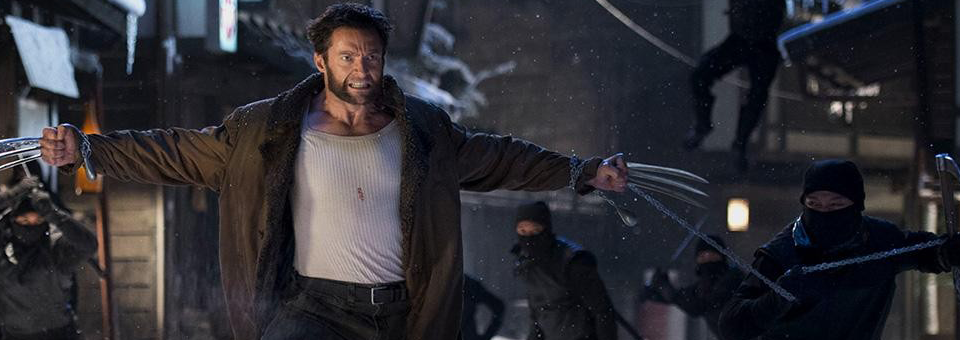One would think making a forceful movie about one of the most beloved and badass characters in fictional history would be simple, if not downright easy. And yet time and time again, Wolverine finds himself neutered by the powers that be, his complexities reduced as his claws are engorged, grandiose fight scenes displacing characterization, any and all subtlety tossed out the window in favor of ham-handedly bludgeoning the audience over the head with Bond-villian-esque exposition. Wolverine has never come close to realizing his potential on film.
After a flashback to WWII, “The Wolverine” picks up some time after the events of “X-Men: The Last Stand”—Logan is living in the mountains, caveman hairstyling signifying the trauma he experienced when he killed the love of his life in the last X-Men flick. Wolverine is pulled out of his seclusion when some hunters wing this bear pal of his with a poison arrow, forcing him to enact some vengeance as only Wolverine can. While torturing one of the men responsible, Logan meets a mysterious woman who has been sent to retrieve the X-Man. Turns out her master, a man named Yashida who Wolverine saved from a nuke back in WWII, wants a word. Yashida is dying, and in his desperation he tells Wolverine that he can end the seemingly immortal mutant’s suffering by taking his healing factor for his own. Wolverine refuses, but in doing so loses his healing factor anyway and becomes entangled with shady businessmen, Yakuza, and a romantic interest—all with his diminished powers.
Let’s be clear—the idea of taking away Logan’s healing factor is a stroke of genius because it greatly raises the stakes for an almost impervious character, but it is completely undone by the film’s execution. For one, there are tremendous inconsistencies with his powers. While a gun shot wound will leave him bleeding, the withdrawal of his claws each and every time he fights leaves his hands without a scratch. Beyond that, raised stakes means that fight scenes could have been approached with more subtlety and nuance. Instead Wolverine basically takes his usual pounding for two hours, getting shot left and right and shaking it off. Raise those stakes: let’s see a gunshot put him down, let’s see how a fight scene against two guys with swords threatens everything, instead of watching him, like every other good guy action hero in the last decade, fight guys on top of a train without any novelty. The fight scenes are just bad—pure maximalism, and not even exciting maximalism at that. They’re made all the worse by vaudevillian sound effects (we’re talking Bugs Bunny style here) when people do anything. How are the ninjas so sneaky when they’re constantly making whoosh noises every time they throw in an unnecessary double flip inside a dude’s house?
As bad as the fight scenes are, nothing can compare to the dialogue. What makes it so horrendous is not necessarily it’s attempted badassery, which has caused other comic book movies to sound so bad, but rather the extreme exposition. Every single plot point is touched upon in graphic detail by every character. Wolverine even talks to himself at times, you know, just in case he himself doesn’t understand that Japanese people use two hands on their swords (yes, this is an actual thing that he articulates to himself, out loud, while putting two hands on the sword, after he is told that’s how it’s done earlier in the movie). It’s impossible to give further example without throwing in spoilers, because everyone from the villains to Wolverine himself go out of there way to narrate everything that is happening/has happened.
Why can’t Hollywood understand that making a good comic book movie equates to just making a good movie, and forgetting the comic book side of things. Make compelling characters. Write good dialogue. Don’t just rest on the fact that everyone loves Wolverine and that it’s cool when he stabs people with his claws. Make us care about the world you’re creating, not just action. There’s a reason “Iron Man” is probably the best Marvel movie: it’s an action move where the action is the least interesting part of the film. Instead it’s the story, Tony Stark’s progression and interplay, the we care about. And when the fight scenes finally come, we enjoy them because they’re intelligent and because we now care about the hero and his stakes. You can’t just throw a guy on a train and make us care. It’s been done.
Imagine if the right person were hired to direct a Wolverine movie. Imagine if studios cared about the script. Imagine if Quentin Tarantino were behind the camera, bringing the energy and power of “Django” to the likes of Wolverine. After all, comic books are rooted in the contrast between great dialogue and cool battles, and nobody could bring the high epic mentality and witty repartee to the comic book adaptation better than QT.
Alas, that’s wishful thinking.
